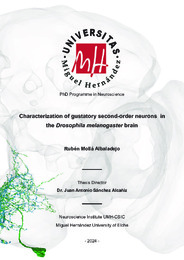Please use this identifier to cite or link to this item:
https://hdl.handle.net/11000/37551Full metadata record
| DC Field | Value | Language |
|---|---|---|
| dc.contributor.advisor | Sánchez Alcañiz, Juan Antonio | - |
| dc.contributor.author | Mollá Albaladejo, Rubén | - |
| dc.contributor.other | Departamentos de la UMH::Patología y Cirugía | es_ES |
| dc.date.accessioned | 2025-09-26T11:08:38Z | - |
| dc.date.available | 2025-09-26T11:08:38Z | - |
| dc.date.created | 2024 | - |
| dc.identifier.uri | https://hdl.handle.net/11000/37551 | - |
| dc.description.abstract | Animals, including the fly Drosophila melanogaster, continuously receive and process sensory information from the surrounding environment via different sensory systems, which ultimately direct appropriate behavioral responses. Among those behaviors, feeding is essential as it is how animals get all the needed nutrients to support their lives. In order to discriminate between nutritious and potentially toxic food, a set of specialized neurons, gustatory receptor neurons (GRNs), housed in gustatory sensilla along the body, express a combination of chemosensory receptors for the detection of food chemicals. These GRNs project their axons to the subesophageal zone (SEZ), the primary taste center in the brain, where gustatory information is integrated primarily by the gustatory second-order neurons (GSON). While much is known regarding the gustatory receptors and the role of GRNs, it is not yet clear how GSONs process the gustatory information conveyed by GRNs to the SEZ. This Thesis aims to understand how GSONs integrate gustatory information in the central brain and how the metabolic state of the flies can modulate this process. Using trans-Tango and fluorescence-activated cell sorting (FACS), we separated the GSONs receiving direct input from sweet, bitter and mechanosensory GRNs in fed and starved conditions to characterize them molecularly by RNA sequencing. Gene analysis expression reveled that GSONs receiving input from sweet, bitter, and mechanosensory neurons segregate molecularly and that their molecular profile varies with the metabolic state of the fly (fed vs. starved). Furthermore, GSONs express a complex combination of neurotransmitters and neuropeptides, indicating that those neurons are not homogenous even when receiving information from the same taste quality. Of all genes analyzed, we found that the neuropeptide Leucokinin (Lk) was highly expressed during starvation by two single neurons located in the SEZ (SELK neurons). Our results revealed that both SELK neurons receive information from sweet and bitter GRNs, validated using different molecular strategies and the recently published Full Adult Fly Brain (FAFB) connectome with Flywire. We consider that those results show for the first time that a neuron in the SEZ directly collects information of opposing valence, sweet and bitter (attractive and repulsive). We tested the functionality of those SELK neurons during feeding behavior in two paradigms: feeding initiation with the Proboscis Extension Response (PER) and feeding two-choice assay with flyPAD. While the expression of tetanus toxin in all Lk neurons does not alter apparently feeding behavior in free-moving flies, our results suggest that SELK neurons are involved in integrating bitter and sweet tastants to tolerate bitter compounds during starvation during feeding initiation. To the best of our knowledge, our work reveals for the first time the molecular transcriptomic profile from two metabolic states of three different taste GSONs populations, highlighting behaviorally the essential role of SELK neurons in directly integrating the sweet and bitter taste information. | es_ES |
| dc.format | application/pdf | es_ES |
| dc.format.extent | 192 | es_ES |
| dc.language.iso | eng | es_ES |
| dc.publisher | Universidad Miguel Hérnández de Elche | es_ES |
| dc.rights | info:eu-repo/semantics/openAccess | es_ES |
| dc.rights | Attribution-NonCommercial-NoDerivatives 4.0 Internacional | * |
| dc.rights.uri | http://creativecommons.org/licenses/by-nc-nd/4.0/ | * |
| dc.subject | Neurociencias | es_ES |
| dc.subject | Comportamiento animal | es_ES |
| dc.subject.other | CDU::6 - Ciencias aplicadas::61 - Medicina | es_ES |
| dc.title | Characterization of gustatory second-order neurons in the Drosophila melanogaster brain | es_ES |
| dc.type | info:eu-repo/semantics/doctoralThesis | es_ES |
| dc.contributor.institute | Institutos de la UMH::Instituto de Neurociencias | es_ES |

View/Open:
Thesis SF Ruben Molla Albaladejo.pdf
12,64 MB
Adobe PDF
Share:
.png)
